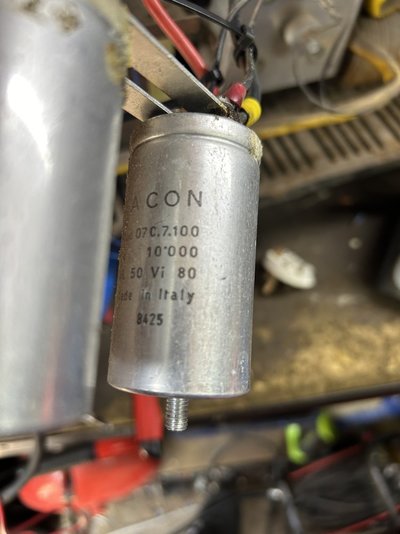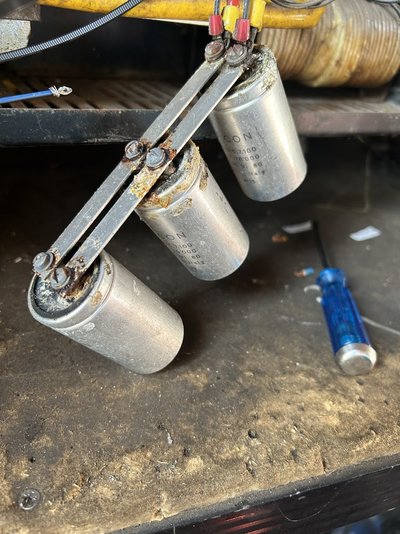You are using an out of date browser. It may not display this or other websites correctly.
You should upgrade or use an alternative browser.
You should upgrade or use an alternative browser.
Clarke 165 caps
- Thread starter Hutcho
- Start date
I agree that 3 of the 12,000uF would do the job. If there is space and you can spare the 4th one, using all four of them will not hurt, the arc will be smoother. It is said that having a bank of multiple smaller capacitors is better than one large one - since they are in parallel, the "Effective Serial Resistance" ESR is reduced.
As for the voltage, 63v is perhaps a bit low. As Seadog said, measure the DC output voltage, with the welder "power" switch stepped up to the maximum. First with no capacitors at all, that will give you the Root Mean Square - rms - value. Then connect the 3 or 4 capacitors and check again. It will be the peak value, which should be 1.414 times the rms value. If this is close to 63v, then you ought to get caps with a higher voltage rating.
As for the voltage, 63v is perhaps a bit low. As Seadog said, measure the DC output voltage, with the welder "power" switch stepped up to the maximum. First with no capacitors at all, that will give you the Root Mean Square - rms - value. Then connect the 3 or 4 capacitors and check again. It will be the peak value, which should be 1.414 times the rms value. If this is close to 63v, then you ought to get caps with a higher voltage rating.
Right brilliant thanks guysI agree that 3 of the 12,000uF would do the job. If there is space and you can spare the 4th one, using all four of them will not hurt, the arc will be smoother. It is said that having a bank of multiple smaller capacitors is better than one large one - since they are in parallel, the "Effective Serial Resistance" ESR is reduced.
As for the voltage, 63v is perhaps a bit low. As Seadog said, measure the DC output voltage, with the welder "power" switch stepped up to the maximum. First with no capacitors at all, that will give you the Root Mean Square - rms - value. Then connect the 3 or 4 capacitors and check again. It will be the peak value, which should be 1.414 times the rms value. If this is close to 63v, then you ought to get caps with a higher voltage rating.
Ok but the bullet and connected them - hiding outside with the test pedal
And with the caps connected I get 43v
Only problem is I don’t think I can squeeze all 4 in so will it be ok with three ? Going to see if I can move things about and see but just incase it’s looking like three caps
And with the caps connected I get 43v
Only problem is I don’t think I can squeeze all 4 in so will it be ok with three ? Going to see if I can move things about and see but just incase it’s looking like three caps
The rms value of 30v DC multiplied by 1.414 should make 42.4v, so your measured 43v is spot on.
The original capacitor layout was 3 x 10,000, making 30,000uF. You now will have 3 x 12,000, so the total capacity has gone up to 36,000uF. Since the tolerance of large electrolytic capacitors can be + or - 20 percent ( ! ), it is about the same as it was....
The original capacitor layout was 3 x 10,000, making 30,000uF. You now will have 3 x 12,000, so the total capacity has gone up to 36,000uF. Since the tolerance of large electrolytic capacitors can be + or - 20 percent ( ! ), it is about the same as it was....
Brilliant - thanks guys , but if I can make the 4 fit as Iam thinking off mounting them under the top cover it will be ok Eddie ?The rms value of 30v DC multiplied by 1.414 should make 42.4v, so your measured 43v is spot on.
The original capacitor layout was 3 x 10,000, making 30,000uF. You now will have 3 x 12,000, so the total capacity has gone up to 36,000uF. Since the tolerance of large electrolytic capacitors can be + or - 20 percent ( ! ), it is about the same as it was....
And I’ve learnt something new today - thanksThe rms value of 30v DC multiplied by 1.414 should make 42.4v, so your measured 43v is spot on.
The original capacitor layout was 3 x 10,000, making 30,000uF. You now will have 3 x 12,000, so the total capacity has gone up to 36,000uF. Since the tolerance of large electrolytic capacitors can be + or - 20 percent ( ! ), it is about the same as it was....




